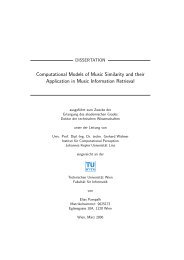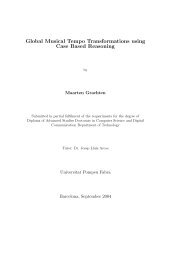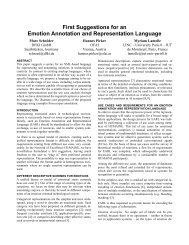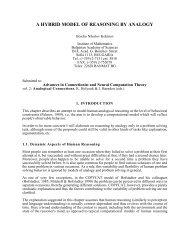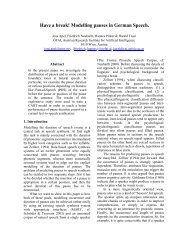Convergent Decomposition Solvers for Tree-reweighted Free ... - OFAI
Convergent Decomposition Solvers for Tree-reweighted Free ... - OFAI
Convergent Decomposition Solvers for Tree-reweighted Free ... - OFAI
You also want an ePaper? Increase the reach of your titles
YUMPU automatically turns print PDFs into web optimized ePapers that Google loves.
<strong>Convergent</strong> <strong>Decomposition</strong> <strong>Solvers</strong> <strong>for</strong> <strong>Tree</strong>-<strong>reweighted</strong> <strong>Free</strong> Energies<br />
running time (s)<br />
800<br />
600<br />
400<br />
200<br />
0<br />
TrwSPG<br />
NoSMP<br />
Naive<br />
TrwDMP<br />
0 5 10 15 20 25 30<br />
outer iteration<br />
(a) accumulated running time<br />
˜Φ<br />
3,300<br />
3,200<br />
3,100<br />
3,000<br />
0 5 10 15 20 25 30<br />
outer iteration<br />
(b) progress of objective<br />
Figure 4: Construction of Optimal sets of spanning trees<br />
<strong>for</strong> Grid IsingUni<strong>for</strong>m—TrwSPG scales linearly until<br />
after the number of trees exceeds the number of CPU cores.<br />
4.2.3 Scalability of Optimal <strong>Tree</strong> Selection<br />
We next considered Optimal tree selection. Here, at<br />
each iteration, the set of trees grows. One might then<br />
expect the running time of Algorithm 1 to increase<br />
at each iteration, such that the accumulated running<br />
time grows superlinearly. We drew on two strategies<br />
in order to suppress this effect. First, by parallelizing<br />
computation, the cost of each iteration could be kept<br />
constant until the number of trees exceeds the number<br />
of cores. Second, by warm-starting Algorithm 1,<br />
almost-constant cost could be maintained up to a relevant<br />
number of iterations: At each outer iteration, we<br />
started from the previous solution ⃗ θ ⋆ ; the additional<br />
parameters θ(T ⋆ ) of the newly added MST were obtained<br />
from the weighted average over the other trees,<br />
θ(T ⋆ ) = ∑ T ′ ∈S\T ⋆ ρ s(T ′ )θ ⋆ (T ′ ). All parameters were<br />
then projected to obtain an initial feasible point.<br />
Figure 4 shows a run of the Optimal<strong>Tree</strong>s algorithm.<br />
We compared our actual implementation<br />
(TrwSPG) to an implementation that does not use<br />
multi-processing (NoSMP) and a naive implementation<br />
that uses neither warm-starting nor multiprocessing<br />
(Naive). As one can see, the differences<br />
are dramatic. Finally, we assessed an implementation<br />
(TrwDMP) that uses damped (α = 0.5) message<br />
passing to solve the inner problem, as in Wainwright<br />
et al. (2005a). Figure 4 shows that up to a<br />
relevant number of iterations, this is less efficient than<br />
the TrwSPG-based scheme. Moreover, one does not<br />
know in advance which damping factor to choose.<br />
5 RELATED WORK<br />
Our <strong>for</strong>mulation is most closely related to the dual decomposition<br />
scheme of Komodakis et al. (2007), who<br />
optimize an upper bound on the MAP score. As opposed<br />
to our setting, there is no strong duality between<br />
the (discrete) primal MAP problem and minimization<br />
of the convex upper bound, hence primal solutions<br />
must be generated heuristically. Moreover, the<br />
upper bound on the MAP score is non-differentiable,<br />
which has recently been dealt with using proximal regularization<br />
(Jojic et al., 2010). On the other hand, the<br />
upper bound on the log partition function depends on<br />
the choice of trees, a different source of complication.<br />
Several independent lines of work have focused on convergent<br />
algorithms <strong>for</strong> convex free energies. Heskes<br />
(2006) derives convergent double-loop algorithms. He<br />
also argues that given sufficient damping, the original<br />
algorithm of Wainwright et al. (2005b) should<br />
converge. Globerson and Jaakkola (2007) provide<br />
a convergent algorithm <strong>for</strong> tree-<strong>reweighted</strong> free energies<br />
that solves an unconstrained geometric program.<br />
However, the authors note their work is mostly of theoretical<br />
interest, since “damped” message passing converges<br />
more rapidly. Hazan and Shashua (2008) devise<br />
a convergent algorithm <strong>for</strong> general convex energies by<br />
imposing strict non-negativity constraints on certain<br />
coefficients of the entropy terms. Meltzer et al. (2009)<br />
provide a unifying view that relates convergence to the<br />
order in which message updates are per<strong>for</strong>med.<br />
Concerning parallelization, Gonzalez et al. (2009) devise<br />
an efficient concurrent implementation of belief<br />
propagation. They show that synchronous schedules,<br />
which are naturally parallel, converge less rapidly—<br />
both empirically and theoretically. Hence, the authors<br />
parallelize a residual-based asynchronous schedule,<br />
which requires locking and considerable engineering<br />
ef<strong>for</strong>t. Moreover, their algorithm is not guaranteed<br />
to converge. On the other hand, some schemes that do<br />
guarantee convergence—such as that of Meltzer et al.<br />
(2009)—rely on the order of updates, which makes it<br />
inherently hard to gainfully employ parallelization.<br />
6 CONCLUSION<br />
We presented convergent optimization schemes <strong>for</strong><br />
computation of approximate marginal probabilities in<br />
cyclic graphical models. For tree-<strong>reweighted</strong> energies<br />
arising from a small number of spanning trees, our<br />
SPG-based solver was shown to be more efficient than<br />
the original message passing algorithm, while guaranteeing<br />
convergence. Moreover, we found empirically<br />
that such energies provide approximations of reasonable<br />
quality. If more accurate approximations are desired,<br />
one can additionally optimize over the choice of<br />
trees. Towards this end, we outlined an efficient algorithm<br />
that draws on our convergent solvers at each<br />
iteration to establish the joint global optimum.<br />
Acknowledgements<br />
We thank our reviewers. <strong>OFAI</strong> is supported by the<br />
Austrian Federal Ministry <strong>for</strong> Transport, Innovation,<br />
and Technology. JJ and GM acknowledge funding by<br />
WWTF Grant ICT10-049 and FWF Grant S10606.




